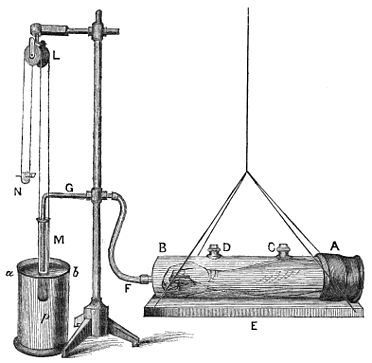ries a kymographic pen, suitable for drawing a line upon a sheet of paper drawn past the point of the pen by a clock-work constructed for that purpose.
The test-tube M is so hung that its axis is traversed by the vertical descending limb of the glass tube G, and the test-tube can move up or down without striking the tube occupying its center.

Fig. 1.—Mosso's Plethysmograph.
If, now, the glass cylinder containing the arm and the tubes F and G are filled with water, and the arm begins to expand, then the water will be forced out into the test-tube M, which will therefore descend into the fluid in the beaker, P, raising, as it descends, the counter-weight and pen, N. If, on the contrary, the arm contracts, the water will be sucked back, the test-tube M will be lighter, the counter-weight will pull it back, and the pen will descend. Let us suppose that the point of the pen rests against a sheet of paper which is being drawn along horizontally with a constant velocity. As long as the pen is stationary it will draw a horizontal line; if it ascends, it will draw an ascending curve; when it falls, a descending curve. Such a line is technically termed a tracing. It shows the extent and duration of the motion, and exemplifies one of the many applications of the graphic

